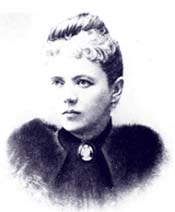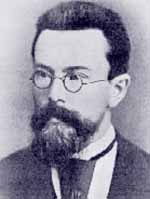 Article provided by Joe Moreno - ©1998 Though by some margin the shortest of Tchaikovsky's symphonies, this is not a "little Russian" symphony as distinct from a "great Russian" symphony. The nickname, conferred by Nikolai Dimitrievich Kashkin, a Moscow music critic and acquaintance of Tchaikovsky's, refers to Little Russia, an affectionate name for
In his letters that fall Tchaikovsky laments his loneliness, missing the meat pastries, the pelmeny, at his father's house and wishing that the Davidovs might move to Moscow. But in what he says about his new symphony he is optimistic. He played the finale at a Christmas party at the Rimsky-Korsakovs and recounts how he was nearly torn to pieces by the enraptured company, his hostess insisting that he should make a piano duet arrangement forthwith. The premiere, too, went well, and on February 5, 1873 he was able to tell his father, "My symphony was played here last week with great success. I was called for many times and cheered repeatedly. The success was so great that the symphony will be played again at the tenth concert, and a subscription has been started to make me a present. Also I received 300 rubles from the Musical Society. . . . I am delighted with all the success and the material profit that has accrued from it." The enthusiasm of the Rimsky-Korsakovs, Maestro and Madame, was significant. At this time Russian musical life was split into two factions, the westward-facing,
The question of the 1879 revision of the Little Russian Symphony is interesting. Tchaikovsky destroyed the original score, though it was later reconstructed from surviving orchestral material. By his own account, he "composed the first movement afresh, leaving only the introduction and coda in their original form; rescored the second movement; shortened and rescored the third movement; and shortened and rescored the finale." Kashkin and Tchaikovsky's pupil Sergei Ivanovich Taneyev, himself an excellent composer, are two considerable dissenters from Tchaikovsky's belief that he had done nothing but improve a score that he called "impossible . . . difficult, noisy, disjointed, and muddle-headed." David Brown, Tchaikovsky's most important English-language biographer, also has doubts. I have not heard nor even seen the 1872 score. From Brown's detailed account in the first volume of his biography I infer that at the very least, as in many famous revisionsMessiah, Don Giovanni, and Petrushka are a few examples that come to mindgreat gains were not achieved without considerable losses. Like almost every major work of Tchaikovsky, this one begins with a fairly slow introduction. A single horn sustains one of the notes of the peremptory chord with which the symphony begins, and that note is the first of a Ukrainian song, "Down by Mother Volga." John Warrack points out in his Tchaikovsky biography that it "also bears some relation to a city song, 'O You Winter, Little Winter'; it was a student favorite and associated with the Cossack rebel Stenka Razin." Its downward droops and its way of traversing and re-traversing the same figures give it an unmistakably Russian flavor. Something exotic is contributed by the odd seven-measure phrase length. After the horn comes the turn of the bassoon, and that instrument is accompanied by plucked cellos and basses whose figurations resemble blurred echoes of the tune itself. The horn picks it up again, this time against a background of sustained strings and soft but nervously pulsating woodwind chords. This procedure of presenting an unchanging tune against a constantly changing background, something Tchaikovsky probably learned from the delightful Kamarinskaya of Glinka, the "great avatar of Russian music," as Stravinsky called him, sustains the entire ample and imaginative introduction. That section comes full circle when we hear the tune played again on two unaccompanied horns. Then Tchaikovsky moves briskly into a sonata movement at a lively tempo. The atmosphere is quite different now, though it is not farfetched to hear some relationship between the new melodies and the Volga song, and after a while, the latter actually reappears, first on the clarinet, then on a succession of wind instruments. The development, while not complex, is skillfully laid out; in fact, the development sections in Tchaikovsky's later works are not always this sure. The movement as a whole has an interestingly imagined, effective shape. I hear it as a broad crescendo (in intensity, that is, not literally in volume), that is cut off by a sudden and touching subsidence in which "Mother Volga" makes one final appearance. This last time the song is again given to the horn, but with the accompaniment previously associated with the bassoon, while to the bassoon falls the task of tagging a ruminative echo onto the tune itself. This is a symphony without any really slow music, nothing slower at any rate than the not terribly slow Andante sostenuto of the introduction. Where we might now expect a slow movement, Tchaikovsky gives us a march, music he recycled from Undine, an opera he began and abandoned in 1869. This is like a slightly exotic path off the main road that leads from Schubert to Mahler. Tchaikovsky uses it as the anchor of a simple but charming rondo, whose second episode, a clarinet tune with flute accompaniment, is another Little Russian song, "Spin, o my spinner." The movement ends with a "disintegrating" coda of the kind invented by Beethoven for the funeral march of the Eroica. Next comes a brilliant scherzo. It carries reminiscences of the corresponding movement of Borodin's Symphony No. 1 (1867) and, far more familiar to most of us, of the "Queen Mab" Scherzo in Berlioz's Roméo et Juliette. In contrast to the 3/8 measures of the scherzo itself, the trio is a chattering movement in duple meter, perhaps a folk song (but, if so, not yet firmly identified as such). A portentousmock-portentous, that isintroduction prepares the spirited and swift finale that so delighted the gathering chez Rimsky-Korsakov. The main theme is a song called "The Crane." This, too, Tchaikovsky treats with that same Glinkaesque "changing background" technique of orchestral variation that he used so effectively with "Down by Mother Volga" at the beginning of the symphony. For contrast, he introduces a melody whose delightfully quirky metric suggests either a peg-legged waltz or a rumba. A little later, after a make-believe catastrophe, this is developed in a more staccato style, and at that point one understands very clearly one of the reasons Stravinsky was so fond of this piece. The play catastrophe returns, emphasized this time with a fortissimo stroke on the tam-tam, and then comes the coda. Tchaikovsky could be insistent when it came to letting you know that a piece was about to be over, and this is a case in point. Visit his page: Mozart Experience/Beethoven Experience |
| Home |
1998-9 by Gretchen Lamb |

